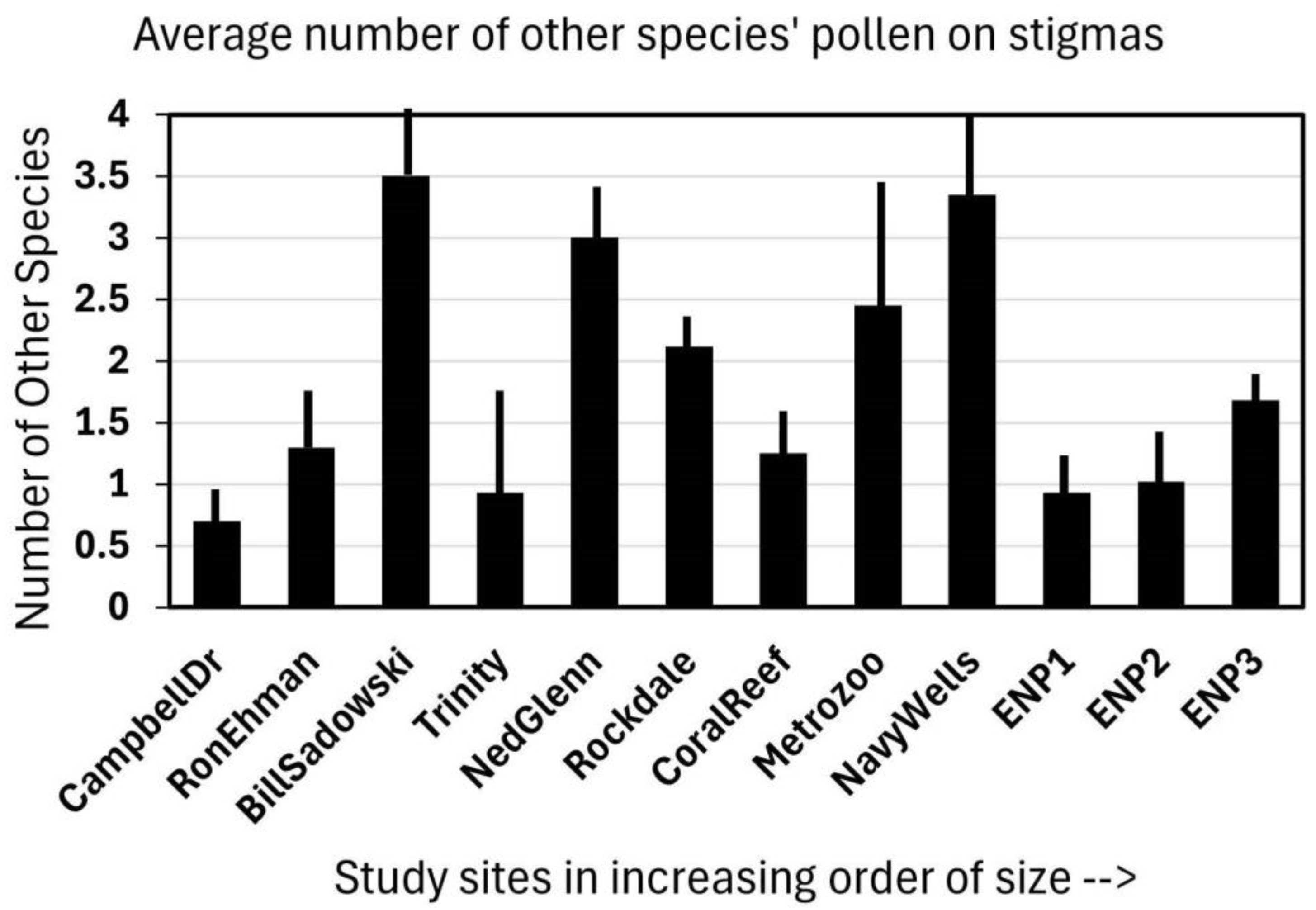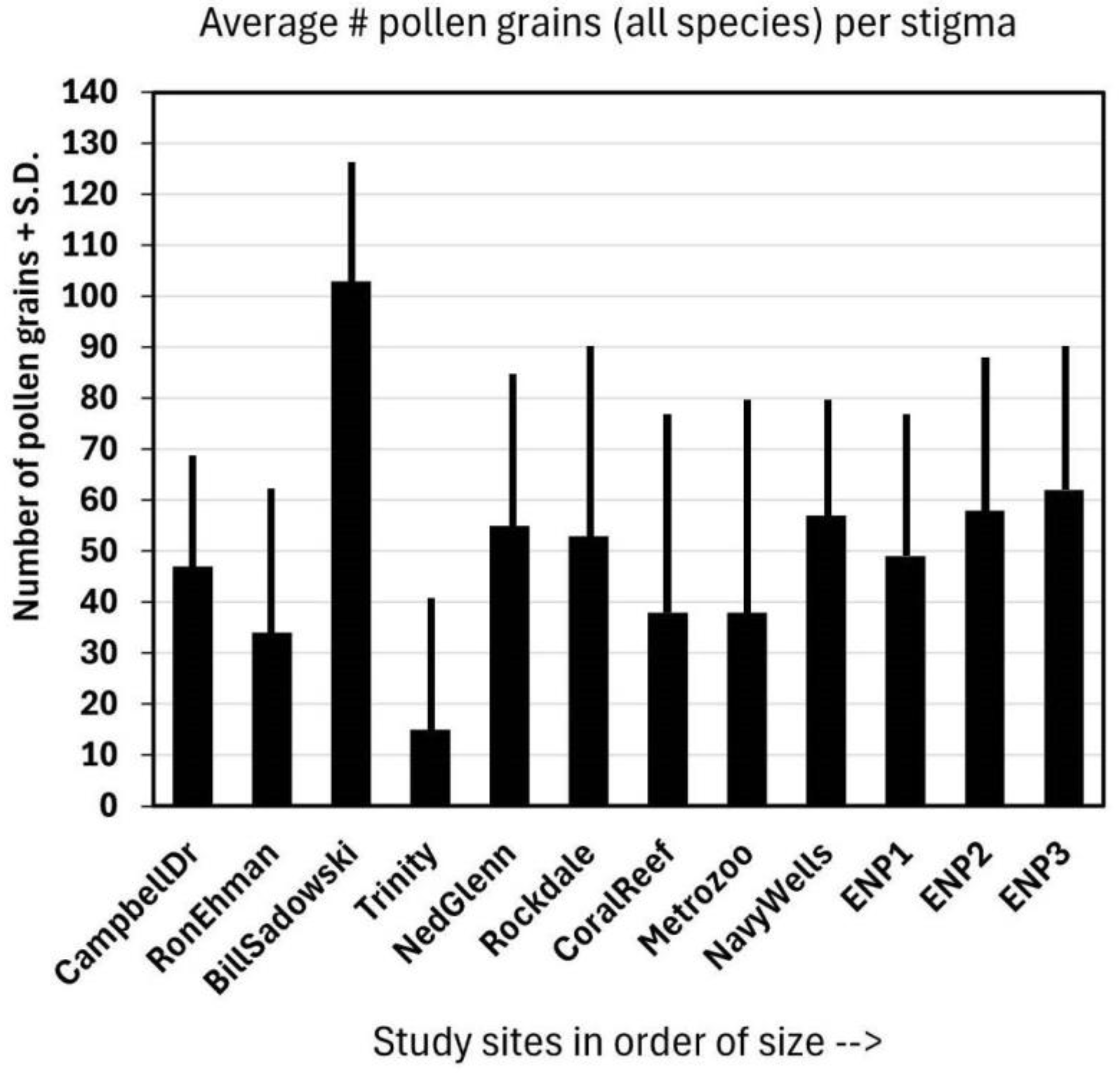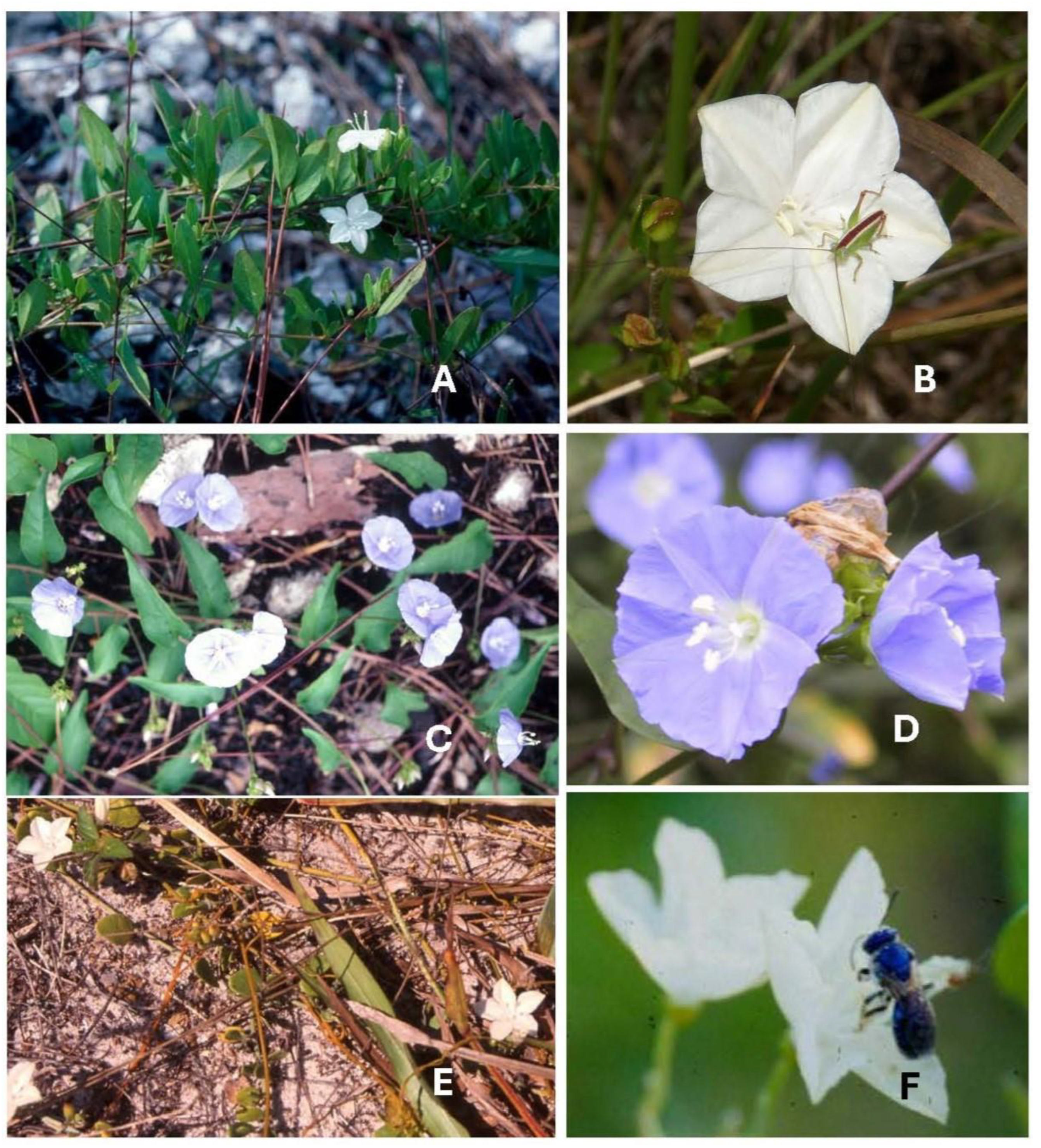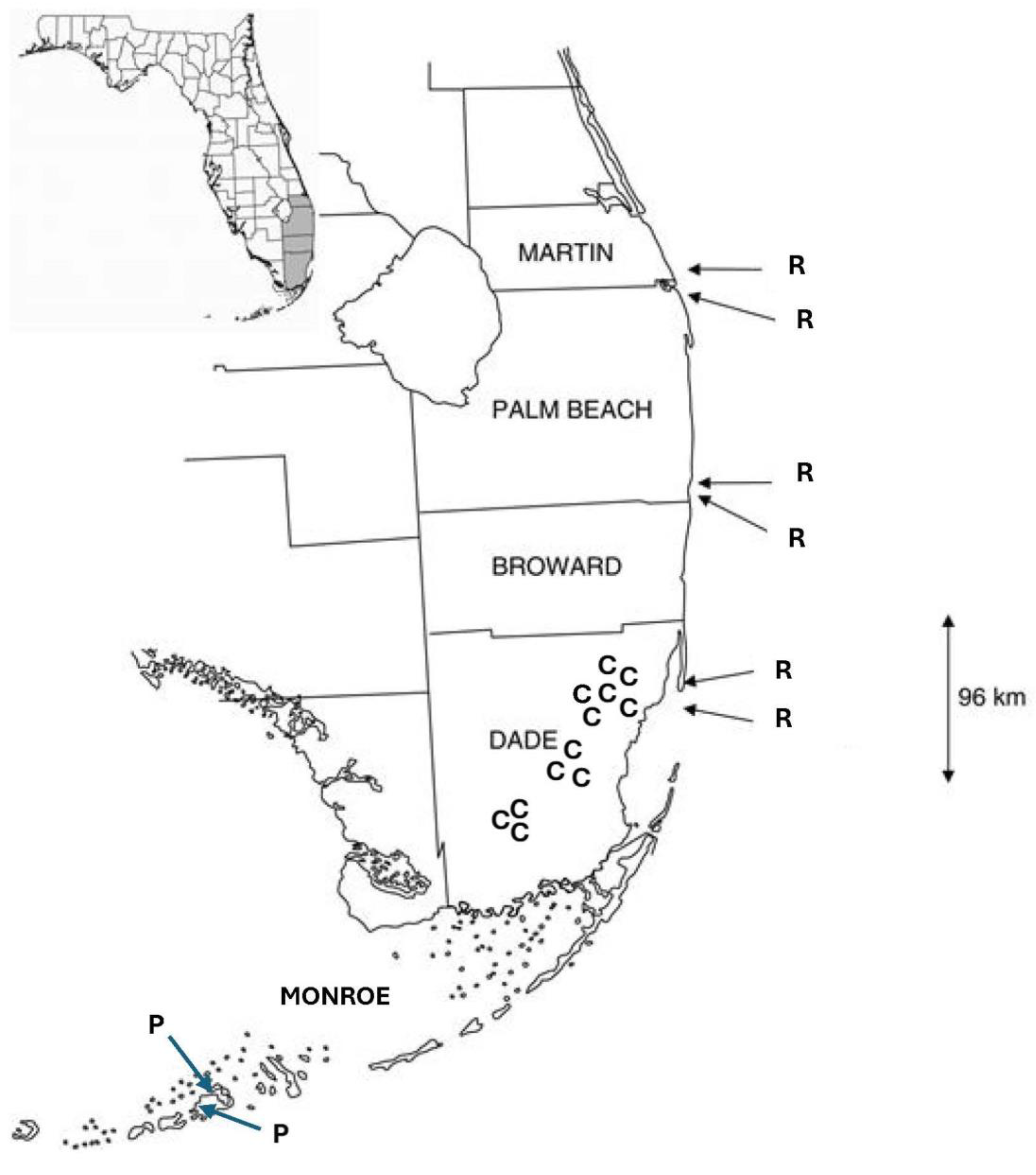Generalization on Both Sides of a Mutualism: Pollinators of Jacquemontia curtisii in Southern Florida
Abstract
1. Introduction
2. Results
2.1. Visitor Species Richness
2.2. Pollen/Ovule Ratios
2.3. Pollen on Stigmas
3. Discussion
4. Materials and Methods
4.1. Study Species
4.2. Field Methods
5. Conclusions
Funding
Institutional Review Board Statement
Data Availability Statement
Acknowledgments
Conflicts of Interest
References
- Haber, W.A.; Frankie, G.W. A tropical hawkmoth community: Costa Rican dry forest Sphingidae. Biotropica 1989, 21, 155–172. [Google Scholar] [CrossRef]
- Austin, D.F. Moon–flower (Ipomoea alba, Convolvulaceae)—Medicine, rubber enabler, and ornamental: A review. Econ. Bot. 2013, 67, 244–262. [Google Scholar] [CrossRef]
- Galetto, L.; Bernardello, G. Floral nectaries, nectar production dynamics and chemical composition in six Ipomoea species (Convolvulaceae) in relation to pollinators. Ann. Bot. 2004, 94, 269–280. [Google Scholar] [CrossRef]
- McMullen, C.K. Pollination biology of a night-flowering Galápagos endemic, Ipomoea habeliana (Convolvulaceae). Bot. J. Linn. Soc. 2009, 160, 11–20. [Google Scholar] [CrossRef][Green Version]
- Johnson, S.D.; Raguso, R.A. The long-tongued hawkmoth pollinator niche for native and invasive plants in Africa. Ann. Bot. 2016, 117, 25–36. [Google Scholar] [CrossRef]
- Caballero Martínez, L.A.; Aguilera-Gómez, L.I.; Rivas-Manzano, I.; Aguilar-Ortigoza, C.; Lamus-Molina, V. Biología floral y polinización de Ipomoea murucoides Roem. and Schult. (Convolvulaceae) en Ixtapan del Oro, Estado de México (México). An. Biol. 2012, 34, 65–76. [Google Scholar] [CrossRef]
- Machado, I.C.S.; Sazima, M. A comparative study in floral biology of two weed species Ipomoea hederifolia and Ipomoea quamoclit Convolvulaceae. Rev. Bras. Biol. 1987, 47, 425–436. [Google Scholar]
- Geiger, J.H.; Meerow, A.W.; Lewis, C.; Oviedo, R.; Francisco-Ortega, J. Genetic diversity and conservation of Ipomoea microdactyla (Convolvulaceae): An endemic vine from the Bahamas, Cuba, and southeastern Florida. Plant Species Biol. 2014, 29, 2–15. [Google Scholar] [CrossRef]
- Wolfe, L.M.; Sowell, D.R. Do pollination syndromes partition the pollinator community? A test using four sympatric morning glory species. Int. J. Plant Sci. 2006, 167, 1169–1175. [Google Scholar] [CrossRef]
- Devall, M.S.; Thien, L.B. Factors influencing the reproductive success of Ipomoea pes-caprae (Convolvulaceae) around the Gulf of Mexico. Am. J. Bot. 1989, 76, 1821–1831. [Google Scholar] [CrossRef]
- Jia, X.; Li, X.; Wang, Y.; Xiaocheng, J. Pollination biology of an invasive weed Ipomoea cairica (Convolvulaceae) in Guangdong Province, China. Sheng Wu Duo Yang Xing 2007, 15, 592–598. [Google Scholar] [CrossRef]
- Paz, J.R.L.d.; Pigozzo, C.M. Pollination of two sympatric species of Ipomoea L. (Convolvulaceae) in an urban remnant of Mata Atlantica, BA, Brazil. Naturalia 2012, 35, 27–45. [Google Scholar]
- das Neves, E.L.; Taki, H.; Kevan, P.G. Flower characteristics and visitors of Merremia macrocalyx (Convolvulaceae) in the chapada diamantina, Bahia, Brazil. Lundiana 2006, 7, 97–102. [Google Scholar] [CrossRef]
- Santos, S.K.D.; Gimenes, M. The efficiency of bees in pollinating ephemeral flowers of Jacquemontia bracteosa (Convolvulaceae). Iheringia 2016, 106, e2016025. [Google Scholar] [CrossRef]
- Murcia, C. Effect of floral morphology and temperature on pollen receipt and removal in Ipomoea trichocarpa. Ecology 1990, 71, 1098–1109. [Google Scholar] [CrossRef]
- Paz, J.; Gimenes, M.; Pigozzo, C.M. Three diurnal patterns of anthesis in Ipomoea carnea subsp. fistulosa (Convolvulaceae): Implications for temporal, behavioral and morphological characteristics of pollinators? Flora 2013, 208, 138–146. [Google Scholar] [CrossRef]
- Bullock, S.H.; Ayala, R.; Baker, I.; Baker, H.G. Reproductive biology of the tree Ipomoea wolcottiana (Convolvulaceae). Madroño 1987, 34, 304–314. [Google Scholar]
- Hassa, P.; Traiperm, P.; Stewart, A.B. Compatibility systems and pollinator dependency in morning glory species (Convolvulaceae). BMC Plant Biol. 2023, 23, 432. [Google Scholar] [CrossRef]
- Lakshminarayana, G.; Raju, A.J.S. Reproductive biology and ecology of Evolvulus alsinoides and Evolvulus nummularius (Convolvulaceae). Phytol. Balc. 2017, 23, 381–389. [Google Scholar]
- Paul, S.; Das, R.; Chetry, K.; Baishnab, B.; Banik, B.; Datta, B.K. Permanent floral closure enhances the reproductive efficiency in Merremia umbellata subsp. orientalis (Hallier f.) Ooststr. (Convolvulaceae). Plant Ecol. 2023, 224, 491–500. [Google Scholar] [CrossRef]
- Prokop, P.; Neupauerova, D. Flower closure in the field bindweed (Convolvulus arvensis): A field test of the pollination hypothesis. Turk. J. Bot. 2014, 38, 877–882. [Google Scholar] [CrossRef]
- Delgado-Davila, R.; Marten-Rodriguez, S.; Huerta-Ramos, G. Variation in floral morphology and plant reproductive success in four Ipomoea species (Convolvulaceae) with contrasting breeding systems. Plant Biol. 2016, 18, 903–912. [Google Scholar] [CrossRef]
- Piedade-Kiill, L.; Taroda Ranga, N. Floral biology and reproductive system of Jacquemontia multiflora (Choisy) Hallier f. (Convolvulaceae). Rev. Bras. Bot. 2000, 23, 37–43. [Google Scholar]
- Piedade Kiill, L.H.; Simao-Bianchini, R. Reproductive biology and pollination of Jacquemontia nodiflora (Desr.) G. Don (Convolvulaceae) in Caatinga, in Petrolina region, Pernambuco State, Brazil. Hoehnea 2011, 38, 511–520. [Google Scholar]
- Shay, K.R.; Drake, D.R. Pollination biology of the Hawaiian coastal vine Jacquemontia sandwicensis (Convolvulaceae). Pac. Sci. 2018, 72, 485–499. [Google Scholar] [CrossRef]
- Silva, F.O.; Kevan, S.D.; Roque, N.; Viana, B.F.; Kevan, P.G. Records on floral biology and visitors of Jacquemontia montana (Moric.) Meisn. (Convolvulaceae) in Mucugê, Bahia. Braz. J. Biol. 2010, 70, 671–676. [Google Scholar] [CrossRef]
- Pinto-Torres, E.; Koptur, S. Hanging by a coastal strand: Breeding system of a federally endangered morning-glory of the south-eastern Florida coast, Jacquemontia reclinata. Ann. Bot. 2009, 104, 1301–1311. [Google Scholar] [CrossRef]
- Montgomery, B.R.; Rathcke, B.J. Effects of floral restrictiveness and stigma size on heterospecific pollen receipt in a prairie community. Oecologia 2012, 168, 449–458. [Google Scholar] [CrossRef] [PubMed]
- Waser, N.M.; Chittka, L.; Price, M.V.; Williams, N.M.; Ollerton, J. Generalization in pollination systems and why it matters. Ecology 1996, 77, 1043–1060. [Google Scholar] [CrossRef]
- Landry, C.L.; Elliott, N.B.; Vitale, M.R. Nesting ecology of Megachile (Pseudocentron) alleni Mitchell (Hymenoptera: Megachilidae) on San Salvador Island, the Bahamas. J. Kans. Entomol. Soc. 2014, 87, 37–46. [Google Scholar] [CrossRef]
- Cruden, R.W. Pollen ovule ratios: A conservative indicator of breeding systems in flowering plants. Evolution 1977, 31, 32–46. [Google Scholar] [CrossRef] [PubMed]
- Harder, L.D.; Johnson, S.D. Beyond pollen:ovule ratios: Evolutionary consequences of pollinator dependence and pollination efficiency for pollen and ovule production in angiosperms. Am. J. Bot. 2023, 110, e16177. [Google Scholar] [CrossRef]
- Caruso, C.M. Pollination of Ipomopsis aggregata (Polemoniaceae): Effects of intra- vs. interspecific competition. Am. J. Bot. 1999, 86, 663–668. [Google Scholar] [PubMed]
- Waser, N. Interspecific pollen transfer and competition between co-occuring plant species. Oecologia 1978, 36, 223–236. [Google Scholar]
- Waser, N.M.; Fugate, M.L. Pollen precedence and stigma closure a mechanism of competition for pollination between Delphinium nelsonii and Ipomopsis aggregata. Oecologia 1986, 70, 573–577. [Google Scholar]
- Fang, Q.; Zhang, T.; Montgomery, B.R. Spatial variation of pollen receipt and effects of heterospecific pollen on seed set in Salvia przewalskii. Ecol. Evol. 2023, 13, e9795. [Google Scholar] [CrossRef] [PubMed]
- Lanuza, J.B.; Bartomeus, I.; Ashman, T.; Bible, G.; Rader, R. Recipient and donor characteristics govern the hierarchical structure of heterospecific pollen competition networks. J. Ecol. 2021, 109, 2329–2341. [Google Scholar] [CrossRef]
- Santos, B.Y.M.; Costa, K.d.M.; de Almeida, N.M.; Buril, M.T.; Santos, A.M.M.; Leite, A.V. Influence of incompatible pollen grains on the reproductive success of Ipomoea asarifolia (Desr.) Roem. & Schult. (Convolvulaceae) in Restinga, RN, Brazil. Rev. Bras. Bot. 2024, 47, 229–234. [Google Scholar] [CrossRef]
- Koptur, S.; Barrios, B. Are native palms “pollinator hogs”? A field experiment in pine rocklands of southern Florida. Nat. Areas J. 2020, 40, 142–149. [Google Scholar] [CrossRef]
- Koptur, S.; Khorsand, R. Pollination ecology of three sympatric palms of southern Florida pine rocklands. Nat. Areas J. 2018, 38, 15–25. [Google Scholar] [CrossRef]
- Florida Natural Areas Inventory. Pine Rockland. In Guide to the Natural Communities of Florida; Florida Natural Areas Inventory: Tallahassee, FL, USA, 2010; pp. 69–72. [Google Scholar]
- Koptur, S. The conservation of specialized and generalized pollination systems in subtropical ecosystems: A case study. In Plant–Pollinator Interactions: From Specialization to Generalization; Waser, N., Ollerton, J., Eds.; University of Chicago Press: Chicago, IL, USA, 2006; pp. 341–361. [Google Scholar]
- Possley, J.; Woodmansee, S.W.; Maschinski, J. Patterns of plant composition in fragments of globally imperiled pine rockland forest: Effects of soil type, recent fire frequency, and fragment size. Nat. Areas J. 2008, 28, 379–394. [Google Scholar]
- Possley, J.E.; Maschinski, J.M.; Maguire, J.; Guerra, C. Vegetation Monitoring to Guide Management Decisions in Miami’s Urban Pine Rockland Preserves. Nat. Areas J. 2014, 34, 154–165. [Google Scholar] [CrossRef][Green Version]
- Jolls, C.L.; Inkster, J.N.; Havens, K.; Jolls, C.L.; Inkster, J.N.; Scholtens, B.G.; Vitt, P.; Havens, K. An endemic plant and the plant-insect visitor network of a dune ecosystem. Glob. Ecol. Conserv. 2019, 18, e00603. [Google Scholar] [CrossRef]
- Wei, N.; Kaczorowski, R.L.; Ashman, T.; Wei, N.; Kaczorowski, R.L.; Arceo-Gómez, G.; O’Neill, E.M.; Hayes, R.A.; Ashman, T. Pollinators contribute to the maintenance of flowering plant diversity. Nature 2021, 597, 688–692. [Google Scholar] [CrossRef] [PubMed]
- Spira, T.P. Plant-Pollinator Interactions: A threatened mutualism with implications for the ecology and management of rare plants. Nat. Areas J. 2001, 21, 78–88. [Google Scholar]
- Wunderlin, R.P.; Hansen, B.F. Guide to the Vascular Plants of Florida, 3rd ed.; University Press of Florida: Gainesville, FL, USA, 2011. [Google Scholar]
- Barrios, B.; Arellano, G.; Koptur, S. The effects of fire and fragmentation on occurrence and flowering of a rare perennial plant. Plant Ecol. 2011, 212, 1057–1067. [Google Scholar] [CrossRef]
- Kearns, C.A.; Inouye, D.W. Techniques for Pollination Biologists; University Press of Colorado: Niwot, CO, USA, 1993; 583p. [Google Scholar]
- Dafni, A.; Kevan, P.G.; Husband, B.C. (Eds.) Practical Pollination Biology; Enviroquest, Ltd.: Cambridge, ON, Canada, 2005; 590p. [Google Scholar]
- Willmer, P. Pollination and Floral Ecology; Princeton University Press: Princeton, NJ, USA, 2011; 778p. [Google Scholar]





| Order | Family | Insect | J. curtisii | J. pentanthos | J. reclinata |
|---|---|---|---|---|---|
| DIPTERA | Bombyliidae | Chrysanthrax cypris (Meigen 1820) | X | ||
| Dolichopodidae | Chrysotus sp. | X | |||
| Tachinidae | housefly-type fly | X | |||
| Chloropidae | Liohippelates pusio Loew, 1872 | X | |||
| Syrphidae | Ocyptamus fuscipennis (Say 1823) | X | |||
| Syrphidae | Ocyptamus lineatus (Macquart 1846) | X | |||
| Syrphidae | Palpada vinetorum (Fabricius 1798) | X | |||
| Milichiidae | Pholeomyia sp. | X | |||
| Bombyliidae | Systoechus sp. | X | |||
| Syrphidae | Toxomerus arcifer (Loew 1866) | X | |||
| Syrphidae | Unidentified | X | |||
| Bombyliidae | Unidentified | X | |||
| HETEROPTERA | Cicadellidae | leafhopper | |||
| Cicadellidae | leafhopper | X | X | ||
| HYMENOPTERA | Halictidae | Agapostemon splendens (Lepeletier, 1841) | X | X | |
| Megachilidae | Anthidium notatum rufimaculatum Schwarz | X | |||
| Apidae | Apis mellifera L. 1758 | X | X | ||
| Halictidae | Augochlora pura (Say, 1837) | X | X | ||
| Halictidae | Augochlorella gratiosa (Smith, 1853) | X | |||
| Halictidae | Augochlorella aurata Smith, 1853 | X | X | ||
| Halictidae | Augochloropsis anonyma Cockerell, 1922 | X | X | ||
| Vespidae | Campsomeris plumipes fossulana (Fabricius) | X | |||
| Vespidae | Campsomeris trifasciata (Saussure) | X | X | ||
| Apidae | Ceratina cockerelli (Daly 1973) | X | |||
| Halictidae | Lasioglossum (Evylaeus) nelumbonis Robertson | X | |||
| Halictidae | Lasioglossum (Dialictus) coreopsis (Robertson) | X | |||
| Halictidae | Dialictus sp. | X | X | X | |
| Halictidae | Lasioglossum (Dialictus) tegulare (Robertson) | X | X | ||
| Halictidae | Halictus ligatus Say, 1937 | X | X | ||
| Halictidae | Lasioglossum (Hemihalictus) lustrans Cockerell | X | X | ||
| Megachilidae | Megachile parallela Smith 1853 | X | X | ||
| Megachilidae | Megachile brevis subsp. pseudobrevis Mitchell, 1935 | X | |||
| Megachilidae | Megachile (Sayapis) inimica Cresson, 1872 | X | X | ||
| Megachilidae | Megachile mendica Cresson 1878 | X | |||
| Megachilidae | Megachile sp. ** | X | |||
| Anthophoridae | Melissodes communis Cresson, 1878 | X | X | X | |
| Anthophoridae | Melissoides bimaculata Lepeletier, 1825 | X | |||
| Halictidae | Nomia cf. maneei Cockerell 1910 | X | X | X | |
| Scoliidae | Scolia nobilitata Fabricius, 1805 | X | |||
| Vespidae | Unidentified | X | |||
| Apidae | Xylocopa micans Lepeletier 1841 | X | |||
| LEPIDOPTERA | Nymphalidae | Agraulis vanillae (L.) | X | X | |
| Hesperiidae | Unidentified skippers | X | X | ||
| Total visitor species observed per Jacquemontia species | 19 spp. | 14 spp. | 29 spp. | ||
| Order | Family | Bee ID | # indiv. | Jacq Poll? | # Other spp. | Total spp. |
|---|---|---|---|---|---|---|
| DIPTERA | Bombyliidae | Chrysanthrax cypris | 1 | yes | 2 | 3 |
| Syrphidae | Ocyptamus lineatus | 2 | no | 0 | 0 | |
| Syrphidae | Palpada vinetorum | 1 | no | 3 | 3 | |
| Syrphidae | Syrphid fly | 1 | yes | 1 | 2 | |
| HETEROPTERA | Cicadellidae | Leafhopper | 1 | no | 3 | 3 |
| HYMENOPTERA | Apidae | Apis mellifera | 2 | yes | 2 | 3 |
| Apidae | Ceratina cockgrelli | 1 | yes | 2 | 3 | |
| Apidae | Melissodes communis | 3 | yes | 2–6 | 3–7 | |
| Apidae | Xylocopa micans | 1 | yes | 3 | 4 | |
| Halictidae | Augochloropsis anonyma | 1 | yes | 1 | 2 | |
| Halictidae | Augochlorella gratiosa | 5 | yes | 2–5 | 3–6 | |
| Halictidae | Augochloropsis anonyma | 1 | yes | 1 | 2 | |
| Halictidae | Dialictus coreopsis | 2 | yes | 0–4 | 1–5 | |
| Halictidae | Dialictus tegularis | 1 | yes | 2 | 3 | |
| Halictidae | Halictus ligatus | 2 | yes | 3–6 | 4–7 | |
| Megachilidae | Megachile brevis pseudobrevis | 1 | yes | 2 | 3 | |
| Megachilidae | Megachile mendica | 1 | yes | 4 | 5 | |
| Scoliidae | Scolia nobilitata | 2 | yes | 3–4 | 4–5 | |
| Vespidae | Campsomeris trifasciatus | 1 | yes | 3 | 4 |
Disclaimer/Publisher’s Note: The statements, opinions and data contained in all publications are solely those of the individual author(s) and contributor(s) and not of MDPI and/or the editor(s). MDPI and/or the editor(s) disclaim responsibility for any injury to people or property resulting from any ideas, methods, instructions or products referred to in the content. |
© 2025 by the author. Licensee MDPI, Basel, Switzerland. This article is an open access article distributed under the terms and conditions of the Creative Commons Attribution (CC BY) license (https://creativecommons.org/licenses/by/4.0/).
Share and Cite
Koptur, S. Generalization on Both Sides of a Mutualism: Pollinators of Jacquemontia curtisii in Southern Florida. Plants 2025, 14, 1041. https://doi.org/10.3390/plants14071041
Koptur S. Generalization on Both Sides of a Mutualism: Pollinators of Jacquemontia curtisii in Southern Florida. Plants. 2025; 14(7):1041. https://doi.org/10.3390/plants14071041
Chicago/Turabian StyleKoptur, Suzanne. 2025. "Generalization on Both Sides of a Mutualism: Pollinators of Jacquemontia curtisii in Southern Florida" Plants 14, no. 7: 1041. https://doi.org/10.3390/plants14071041
APA StyleKoptur, S. (2025). Generalization on Both Sides of a Mutualism: Pollinators of Jacquemontia curtisii in Southern Florida. Plants, 14(7), 1041. https://doi.org/10.3390/plants14071041







